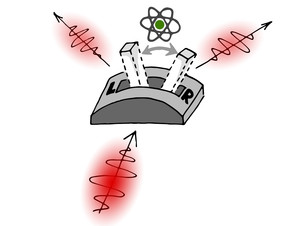A Nov. 5, 2013 Vienna University of Technology press release (also available on EurekAlert) describes research that may make quantum optical switches possible,
With just a single atom, light can be switched between two fibre optic cables at the Vienna University of Technology. Such a switch enables quantum phenomena to be used for information and communication technology.
The press release goes on to describe a ‘light in a bottle’ technique which leads, the researchers hope, that they may have discovered how to create a quantum light switch,
Professor Arno Rauschenbeutel and his team at the Vienna University of Technology capture light in so-called “bottle resonators”. At the surface of these bulgy glass objects, light runs in circles. If such a resonator is brought into the vicinity of a glass fibre which is carrying light, the two systems couple and light can cross over from the glass fibre into the bottle resonator.
“When the circumference of the resonator matches the wavelength of the light, we can make one hundred percent of the light from the glass fibre go into the bottle resonator – and from there it can move on into a second glass fibre”, explains Arno Rauschenbeutel.
A Rubidium Atom as a Light Switch
This system, consisting of the incoming fibre, the resonator and the outgoing fibre, is extremely sensitive: “When we take a single Rubidium atom and bring it into contact with the resonator, the behaviour of the system can change dramatically”, says Rauschenbeutel. If the light is in resonance with the atom, it is even possible to keep all the light in the original glass fibre, and none of it transfers to the bottle resonator and the outgoing glass fibre. The atom thus acts as a switch which redirects light one or the other fibre.Both Settings at Once: The Quantum Switch
In the next step, the scientists plan to make use of the fact that the Rubidium atom can occupy different quantum states, only one of which interacts with the resonator. If the atom occupies the non-interacting quantum state, the light behaves as if the atom was not there. Thus, depending on the quantum state of the atom, light is sent into either of the two glass fibres. This opens up the possibility to exploit some of the most remarkable properties of quantum mechanics: “In quantum physics, objects can occupy different states at the same time”, says Arno Rauschenbeutel. The atom can be prepared in such a way that it occupies both switch states at once. As a consequence, the states “light” and “no light” are simultaneously present in each of the two glass fibre cables. [emphasis mine]For the classical light switch at home, this would be plain impossible, but for a “quantum light switch”, occupying both states at once is not a problem. “It will be exciting to test, whether such superpositions are also possible with stronger light pulses. Somewhere we are bound to encounter a crossover between quantum physics and classical physics”, says Rauschenbeutel.
This light switch is a very powerful new tool for quantum information and quantum communication. “We are planning to deterministically create quantum entanglement between light and matter”, says Arno Rauschenbeutel. “For that, we will no longer need any exotic machinery which is only found in laboratories. Instead, we can now do it with conventional glass fibre cables which are available everywhere.”
Darrick Chang offers a good introduction (i.e., it’s challenging but you don’t need a physics degree to read it) and some analysis of this work in his Nov. 4, 2013 article for Physics (6, 121 (2013) DOI: 10.1103/Physics.6.121) titled: Viewpoint: A Single-Atom Optical Switch.
Quantum scientists over the past two decades have dreamt of realizing powerful new information technologies that exploit the laws of quantum mechanics in their operation. While many approaches are being pursued, a prevailing choice consists of using single atoms and particles of light—single photons—as the fundamental building blocks of these technologies [1]. In this paradigm, one envisions that single atoms naturally act as quantum processors that produce and interface with single photons, while the photons naturally act as wires to carry information between processors. Reporting in Physical Review Letters, researchers at the Vienna University of Technology, Austria, have taken an important step forward in this pursuit, by experimentally demonstrating a microphotonic optical switch that is regulated by just a single atom [2].
This article is open access.
For those willing to tackle a more challenging paper, here’s a link to and a citation for the Vienna University of Technology researchers’ paper,
Fiber-Optical Switch Controlled by a Single Atom by Danny O’Shea, Christian Junge, Jürgen Volz, and Arno Rauschenbeute. Phys. Rev. Lett. 111, 193601 (2013) [5 pages]
This work is behind a paywall.
Minutes after publishing: here’s an image that illustrates superpositioning in a quantum switch,
